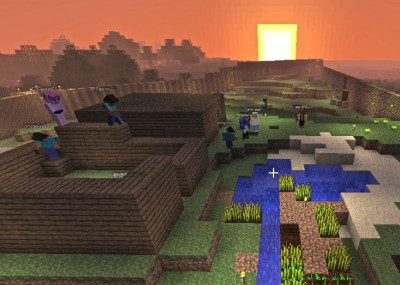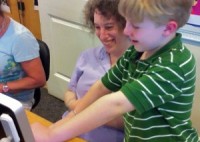
Guest post by Marianne Malmstrom
I’m thrilled by the competency and resourcefulness of my young students. But I also feel an urgency to inform parents and teachers that our children need us to be present and involved online. Just as in “real world” spaces, they require supervision and guidance in virtual spaces. They don’t know to ask for permission to make accounts, connect with friends, create content and join servers – they just do it (to get where they want to go – and because they can). Sometimes it seems they’re born hard-wired to navigate this newly connected world.
As adults, we need to come to grips with the fact that, in many cases, kids are living in these spaces without us. It’s unrealistic to think we can lock them out of the digital world until they turn 13. We need to find constructive ways to connect with them, online as well as offline, because they still need our wisdom. Which is why informed online-safety advocates push for getting virtual environments into school from the earliest grades. Safety is best taught in the process of learning something meaningful to the learner – like an aspiring chef learning safe as well as effective use of knives. We learn safety in the process of practicing and gaining mastery of subjects that interest us.
Tap their wisdom – they love to share it
At home, take the time to play (or watch) games with your children. It’s the most natural as well as effective way to learn how and where they play online. Ask questions. Invite your child to teach you to play the game. Young children are usually very open and happy to share what they know – they’ve proven this to us at the Morrow School over and over again. Make rules and set limits that are appropriate for your child. Be involved in creating accounts. Do your homework and learn about the policies of the games your child plays. Ask them what servers your child visits and read game chat to ensure that activities and language are conducive to your family values. If you don’t know how, ask your child to show you. (Anne Collier wrote more about this here.)

Schools need to develop programs using platforms similar to the ones children use at home. We cannot teach children to swim without water and we cannot teach good citizenship online without places to practice it. Creating these virtual communities allows students the opportunity to practice real skills with teachers present to model and mentor healthy norms. But this will only work if students and teachers become partners in learning. The old “teacher knows best” model will not fly, here. In this new paradigm, we are all learning as we go [see thisabout the “whitewater kayaking kind of learning needed today], and teachers have just as much to learn from our students as they have to learn from us.
Students as curriculum co-creators
Working with students in virtual spaces has been an invaluable resource for us at the Elisabeth Morrow School. It is helping us better understand how kids navigate, connect, work and play online. We are constantly discovering new things that surprise us and challenge some of our preconceived notions. The knowledge we are gaining is allowing us to design programs that are more relevant and effective in addressing our students’ needs (and I’m writing this for parents because this might help you design digitally literate family policy). More importantly, it is enabling us to have meaningful conversations between parents, students and teachers about what safe and civil practices look like in today’s evolving culture. It is empowering to work together to find answers. We find we’re less likely to let fear of the unknown dictate decisions. We’re more willing to seek understanding before addressing “teachable moments.” And, most importantly, we are constantly learning from each other. This kind of partnership is vital if we’re going to continue effectively navigating through and adapting to the constant change we’re all experiencing.
I invite you to join this conversation. Over the next few months, I will share, in more depth and with lots of examples, some of the lessons I’ve learned from my students – and my personal perspective of how we, as parents and teachers, can support this new generation of connected learners.
Your editor, here. I’d love to have you join the conversation too – via comments below. Here are Part 1 and Part 2 of this series. Stay tuned for more from Marianne – only a little more spread out, now, across 2013.
Related links

[…] the classroom. And she’s a leader of teachers and parents who think about the complexities of internet safety for kids. (Hint: The answer is not keeping kids off the Internet—it involves teaching them, as they […]